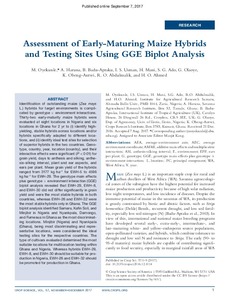| dc.contributor.author | Oyekunle, M. |
| dc.contributor.author | Haruna, A. |
| dc.contributor.author | Badu-Apraku, B. |
| dc.contributor.author | Usman, I.S. |
| dc.contributor.author | Mani, H. |
| dc.contributor.author | Ado, S.G. |
| dc.contributor.author | Olaoye, G. |
| dc.contributor.author | Obeng-Antwi, K. |
| dc.contributor.author | Abdulmalik, R.O. |
| dc.contributor.author | Ahmed, H.O. |
| dc.date.accessioned | 2019-12-04T11:10:16Z |
| dc.date.available | 2019-12-04T11:10:16Z |
| dc.date.issued | 2017-09-07 |
| dc.identifier.citation | Oyekunle, M., Haruna, A., Badu-Apraku, B., Usman, I.S., Mani, H., Ado, S.G., ... & Ahmed, H.O. (2017). Assessment of early-maturing maize hybrids and testing sites using GGE biplot analysis. Crop Science, 57, 1-9. |
| dc.identifier.issn | 0011-183X |
| dc.identifier.uri | https://hdl.handle.net/20.500.12478/2049 |
| dc.description | Article Purchased; Published: 7 Sept. 2017 |
| dc.description.abstract | Identification of outstanding maize (Zea mays L.) hybrids for target environments is complicated by genotype × environment interactions. Thirty-two early-maturity maize hybrids were evaluated at eight locations in Nigeria and six locations in Ghana for 2 yr to (i) identify high-yielding, stable hybrids across locations and/or hybrids specifically adapted to different locations, and (ii) identify ideal test sites for selection of superior hybrids in the two countries. Genotype, country, year, location (country), and their interactive effects were significant (P < 0·01) for grain yield, days to anthesis and silking, anthesis-silking interval, plant and ear aspects, and ears per plant. Mean grain yield of the hybrids ranged from 3177 kg ha−1 for EWH-5 to 4596 kg ha−1 for EWH-29. The genotype main effects plus genotype × environment interaction (GGE) biplot analysis revealed that EWH-29, EWH-8, and EWH-30 did not differ significantly in grain yield and were the most stable hybrids in both countries, whereas EWH-26 and EWH-32 were the most stable hybrids only in Ghana. The GGE biplot analysis identified Samaru, Kafin Soli, and Minjibir in Nigeria and Nyankpala, Damongo, and Fumesua in Ghana as the most discriminating locations. Minjibir (Nigeria) and Nyankpala (Ghana), being most discriminating and representative locations, were considered the ideal testing sites for the respective countries. The type of cultivars evaluated determined the most suitable locations for multilocation testing within Ghana and Nigeria. Whereas hybrids EWH-29, EWH-8, and EWH-30 should be suitable for production in Nigeria, EWH-26 and EWH-32 should be promoted for production in Ghana. |
| dc.description.sponsorship | Drought Tolerant Maize for Africa |
| dc.format.extent | 1-9 |
| dc.language.iso | en |
| dc.subject | Maize |
| dc.subject | Drought Tolerance |
| dc.subject | Early Maturation |
| dc.subject | Gge |
| dc.subject | Maize Hybrid |
| dc.subject | Genotypes |
| dc.subject | Genotype Environment Interaction |
| dc.title | Assessment of early-maturing maize hybrids and testing sites using GGE biplot analysis |
| dc.type | Journal Article |
| dc.description.version | Peer Review |
| cg.contributor.crp | Maize |
| cg.contributor.affiliation | Ahmadu Bello University |
| cg.contributor.affiliation | Savanna Agricultural Research Institute, Ghana |
| cg.contributor.affiliation | International Institute of Tropical Agriculture |
| cg.contributor.affiliation | University of Ilorin |
| cg.contributor.affiliation | Council for Scientific and Industrial Research, Ghana |
| cg.coverage.region | West Africa |
| cg.coverage.country | Ghana |
| cg.coverage.country | Nigeria |
| cg.isijournal | ISI Journal |
| cg.authorship.types | CGIAR and developing country institute |
| cg.iitasubject | Genetic Improvement |
| cg.iitasubject | Maize |
| cg.iitasubject | Plant Genetic Resources |
| cg.journal | Crop Science |
| cg.howpublished | Formally Published |
| cg.accessibilitystatus | Open Access |
| local.dspaceid | 86045 |
| cg.targetaudience | Scientists |
| cg.identifier.doi | http://dx.doi.org/10.2135/cropsci2016.12.1014 |

